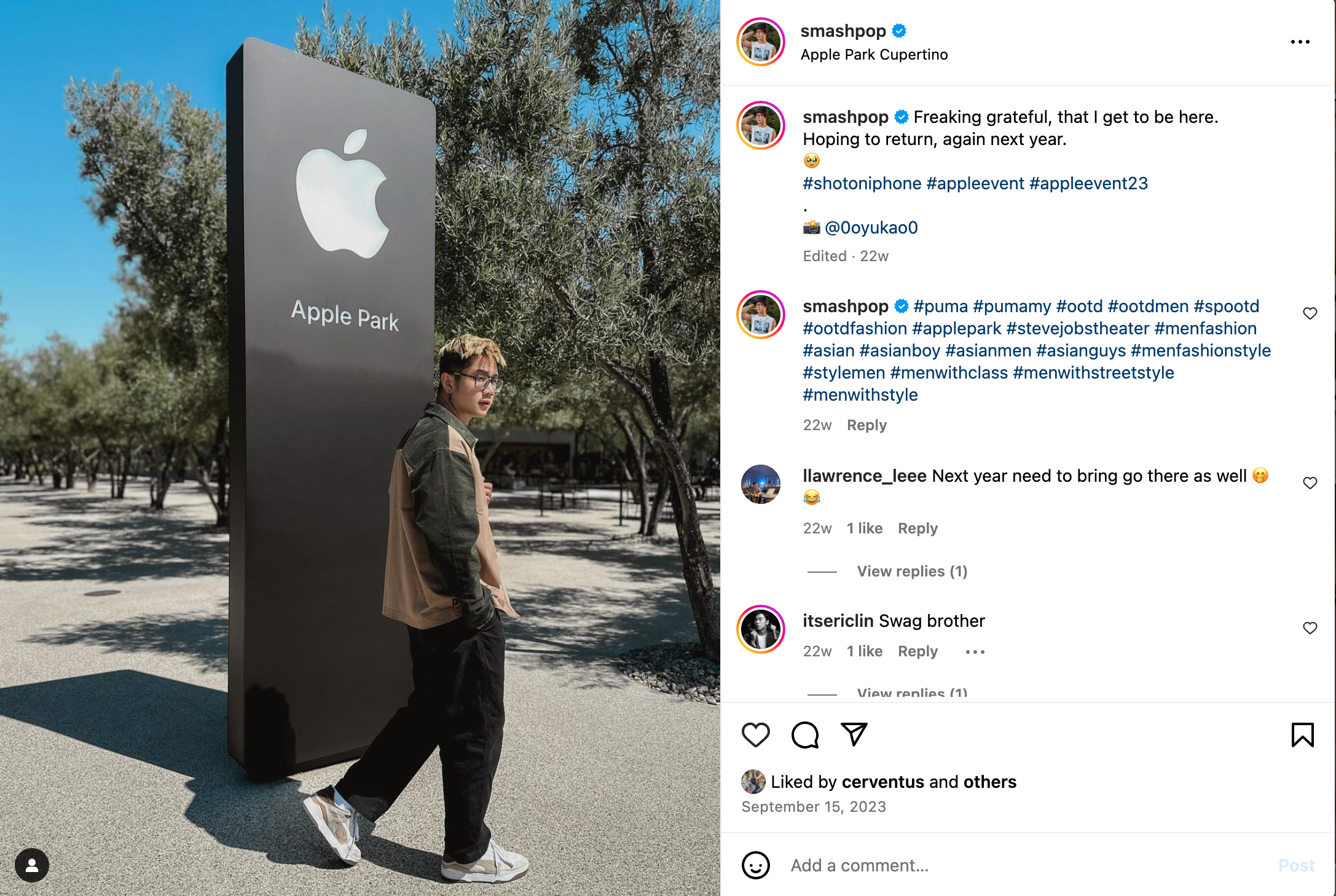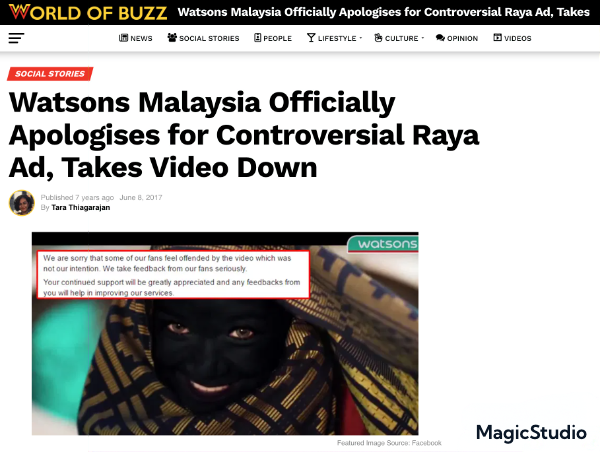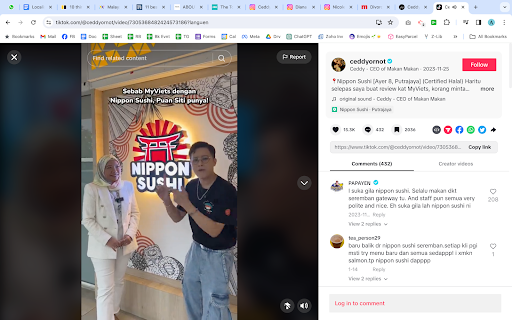The influencer marketing landscape in Malaysia has experienced rapid growth in recent years. Current market surveys show that influencer marketing plays a significant role in influencing consumers’ purchasing decisions.
According to the “E-commerce influencer marketing in Southeast Asia” report released by impact.com and Cube Asia in October 2023, 59 percent of Malaysian respondents admitted to buying something because they viewed recommendations from mega influencers (those boasting more than 1 million followers.)
The fashion industry topped the charts with an impressive 65 percent of participants buying products recommended by influencers. This is followed closely by the beauty industry (62 percent), and the groceries and food industry (41 percent).
Not surprisingly, a large percentage of global brands in Malaysia invest heavily in advertising through influencers. The beauty industry, fashion industry, and 3C industry have all stayed at the forefront of marketing trends and engage local influencers to host events, present live shopping segments, and market on social media.
For example, when the iPhone 15 was launched in September 2023, several Malaysian influencers were flown to the Apple headquarters to film the products, capturing the attention of the Malaysian public.

According to Statista.com, the anticipated ad spending in the influencer advertising market was projected to reach US$59.40 million by the end of 2023.
A. Understanding the Malaysian Market
Understanding the Malaysian market requires a deep dive into its cultural nuances, consumer behavior, regulatory environment, and competitive landscape.
(1) A Multicultural Community
Malaysia stands out due to its multi-ethnic, multilingual, and multicultural composition, making it a unique challenge for marketers.
The multilingual nature of the diverse Malaysian population poses a significant challenge. With a diverse populace, brand strategists and marketers must effectively communicate in multiple languages within the constraints of a single budget. This requires resourcefulness and efficiency to ensure that campaigns resonate across various racial and linguistic groups.

(2) Cultural Nuances
With the multicultural composition of Malaysia’s population, brand marketers must recognize the cultural differences within Malaysia. For instance, family values hold immense significance for the Malay community. In contrast, individual pursuits are prioritized among the Chinese Gen Z.
It would be ideal for brands to hire creative content agencies or brand marketing agencies that understand such cultural nuances in crafting targeted marketing messages that resonate with diverse audiences.
(3) Regulations in Malaysia
Various laws and guidelines govern marketing activities in Malaysia, particularly those concerning cultural sensitivities, religion, and political matters.
Certain content may be considered offensive or inappropriate, particularly about religion and cultural stereotypes. For instance, showing certain body parts like armpits on national TV is prohibited.
In addition, some laws govern political messaging, with a clear directive to avoid engaging in political discussions or content.
When planning their brand marketing strategy, brands must navigate these regulations to ensure compliance and avoid any potential legal issues.
B. How to Localise Your Brand Strategy to the Malaysian Market
In navigating the intricacies of the Malaysian market, global brands must adopt tailored localization strategies to ensure their marketing efforts resonate with consumers.
(1) Adapt to Malaysian Content Messaging and Channels
To cater to Malaysia’s diverse demographics, brands must adapt their content and messaging to resonate with different cultural and linguistic groups. This may involve adapting their message to local lingo, and crafting multiple versions of campaigns while being sensitive towards cultural sensitivity.
To further brand visibility and credibility, brands can leverage Key Opinion Leaders (KOLs) who bridge cultural barriers and resonate with the mass Malaysian audience. For example, brands can select influencers or KOLs who can speak multiple languages to maximize their marketing budget.



Localization of social media marketing channels is another critical aspect. Brands can utilize platforms and mediums preferred by Malaysian audiences of different demographics.
According to market research by impact.com and Cube Asia, YouTube stands out as the most dominant social media and content platform at 84 percent, followed by Facebook (83 percent) and TikTok (79 percent.)
With 30.8 million (92 percent) Malaysians active on social media and high smartphone penetration, there is immense potential for boosting revenue and enhancing marketing effectiveness.
(2) Selecting Malaysian Influencers: Categories and Niches
In Malaysia, influencers span across various categories and can be categorized into several categories, offering brands a wide array of options for collaboration.
- Category: Follower Count
One of the most popular categories is to classify influencers according to their follower count:
- Nano-influencers: 1,000 to 10,000 followers
- Micro-influencers: 10,000 to 50,000 followers
- Mid-Tier-influencers: 50,000 to 500,000 followers
- Macro-influencers: 500,000 to 1 million followers
- Celebrity or Mega-influencers: Over 1 million followers
- Category: Age Group
Beyond their follower count, influencers also vary based on demographics and can be categorized by age groups:
- Gen Z Influencers: Influencers belonging to the Gen Z demographic, typically aged between 15 and 25 years old. They resonate with younger audiences and are influential in shaping trends and preferences among their peers.
- Millennial Influencers: Influencers from the millennial generation, generally aged between 25 and 40 years old. They have significant influence across various industries and are adept at connecting with digitally savvy audiences.
- Category: Interest or Niche
Finally, influencers often specialize in particular interests or niches, allowing brands to target specific audience segments with relevant content.
- Fashion Influencers: Influencers who specialize in fashion-related content, including clothing, accessories, beauty, and style trends.
- Food Influencers: Influencers who focus on culinary experiences, including restaurant reviews, cooking tutorials, and food photography.
- Travel Influencers: Influencers who share their travel experiences, recommendations, and tips for exploring destinations both locally and internationally.
- Fitness Influencers: Influencers who promote health and fitness-related content, including workout routines, nutrition tips, and wellness advice.
- Tech Influencers: Influencers who specialize in technology-related content, including gadget reviews, software tutorials, and industry insights.
- Beauty Influencers: Influencers who focus on beauty trends, offering reviews, tutorials, and tips on achieving various looks and enhancing their features.
- Mommy Influencers: Influencers (particularly mothers) who share insights, advice, and experiences related to parenting, child-rearing, family dynamics, and creating a balance between personal and family life.
Additionally, brands may look for influencers who align with different ethnicities, particularly those from the major cultural groups of Malaysia, comprising the Malay, Chinese, or Indian, catering to the cultural nuances and preferences of Malaysia’s diverse population.
By considering these categories, brands can strategically collaborate with influencers who best align with their campaign objectives and resonate with their target audience, maximizing the impact of influencer marketing efforts in Malaysia.
C. Finding Malaysian Influencers on KOL Radar
KOL Radar is a cutting-edge platform and influencer marketing agency revolutionizing influencer marketing in the Asian region. With our comprehensive suite of features and AI-powered technology, brands can gain access to over 1 billion real-time influencer data points and a database of 2 million international influencer profiles across top social media platforms.
KOL Radar aims to empower brands to identify the most suitable influencers for their campaigns utilizing advanced AI algorithms. KOL Radar is trusted by over 50,000 brands and provides top-notch services ranging from branding and marketing strategy, and planning to influencer collaboration and performance tracking.
Planning Successful Influencer Collaboration with KOL Radar
Collaborating with Malaysian influencers requires careful planning and execution to ensure the success of influencer marketing campaigns.
KOL Radar is an influencer marketing agency that offers a comprehensive solution for all brand owners, marketers and social media agencies.
We offer influencer data analysis, influencer management tools and an AI-powered system that accurately identifies high-performing influencers that align with the brand’s values and objectives. By leveraging KOL Radar’s powerful platform, brands can streamline their influencer marketing campaigns, setting clear campaign objectives and KPIs to measure campaign effectiveness and ROI.
Furthermore, KOL Radar offers comprehensive project services tailored to meet the unique needs of each client, making it the go-to platform for influencer marketing success.
As an influencer marketing agency with experience in executing collaborations with over 10,000 influencers, KOL Radar ensures flawless implementation and communication throughout the collaboration process.
On KOL Radar’s platform, brands can gain access to comprehensive data results and performance reports, thereby offering valuable insights for future branding strategy and marketing optimization.
Conclusion
The influencer marketing landscape in Malaysia continues to thrive, with a substantial impact on consumers’ purchasing decisions. It is paramount for brands to engage social media agencies, brand marketing agencies and influencer marketing agencies to understand the Malaysian market and craft compelling brand marketing strategies that resonate with the Malaysian public.
Global brands can gain a competitive edge by proactively embracing marketing trends and harnessing the influence of local influencers to enhance brand promotion. By strategically collaborating with influencers deeply embedded within local communities, brands can effectively engage target audiences and establish meaningful connections.
With the anticipated growth in influencer advertising spending, influencer marketing platforms and influencer marketing agencies like KOL Radar offer invaluable support in navigating influencer collaborations, ensuring brands effectively reach and resonate with Malaysian consumers, ultimately driving brand success in this dynamic market.

To learn more about marketing strategies for Generation Z and stay updated on the latest influencer marketing trends, inquire with KOL Radar: https://www.kolradar.com/en/.
This article may not be reproduced, redistributed, publicly broadcast, or publicly transmitted without permission. Copyright and portrait rights for images and data referenced in this article still belong to their respective rights holders.



